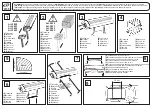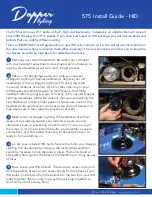
WSM, 124
Section N (Elec. Equip.)
2nd
re-Issue
Page 15
·
STARTER MOTOR
GENERAL
The starter motor is a four-pole, four-brush machine
having an extended shaft to carry the engine
engagement gear or starter drive. This motor is
controlled by a solenoid switch mounted on the
battery carrier and operated by the ignition key
on the instrument panel. In an emergency or for
testing purposes, the solenoid can be operated by
hand by pressing the rubber cap covering the
plunger.
ROUTINE MAINTENANCE
The starter motor fixing bolts should be checked
for tightness periodically.
Remove the metal band cover. Check that the
brushes move freely In their holders by holding back
the brush springs and pulling gently on the flexible
connectors. If a brush Is Inclined to stick, remove
it from its holder and clean Its sides with a petrol
moistened cloth. Be careful to replace brushes In
their original position In order to retain the
"bedding" qualities. Brushes which have worn
so that they will not "bed" properly on the
commutator must be renewed.
The commutator should be clean, free from oil or
dirt and should have a polished appearance. If It Is
dirty, clean It by pressing a fine dry cloth against It
while the starter Is turned by hand by means of a
spanner applied to the squared extension of the
shaft. If the commutator Is very dirty, moisten the
cloth with petrol.
SERVICING
Testing in position
1. Switch on the lamps and operate the starter
control. If the lights go dim, but the starter
motor Is not heard to operate, an indication
Is given that current Is flowing through the
starter motor windings but that the armature
Is not rotating for some reason; possibly the
pinion Is meshed permanently with the geared
ring on the flywheel. In this case the motor
must be removed from the engine for examin
ation.
l. Should the lamps retain their full brilliance
when the starter switch Is operated, check the
circuit for continuity from battery to starter
motor via the starter switch, and examine the
connections at these units. If the switch Is
found to be faulty, a new switch must be fitted.
If the supply voltage Is found to be applied to
the motor when the switch Is operated an
Internal fault In the motor Is indicated and the
unit must be removed from the engine for
examination.
3. Sluggish or slow action of the starter motor
Is usually caused by a poor connection In the
Summary of Contents for ALPINE I SERIES: APLINE II SERIES
Page 1: ......
Page 189: ...Fis 21 Ball pin heirht checkinr fixture in position Details of items 1 to 4 In Fig 22...
Page 208: ...Fla 3 Exploded view of rear axle Hypoid Bevel Drive...
Page 220: ...Page 16 WSM 12 f Section G Rear Axle 0 QQ I I I I I t 0 ii 8 ts t 0 Cl 2 i J...
Page 247: ...Page6 WSM 124 Section J Steering N Iii it...
Page 299: ...Page 40 3 6 7 8 Fis 22 Se rvo unit exploded view Sect WSM 124 ion K Brakes 18 419 GZo 21...
Page 413: ..._ PRINTED IN ENGLAND 9Y WREN PRINTING CQ LTD LONDON...
















































